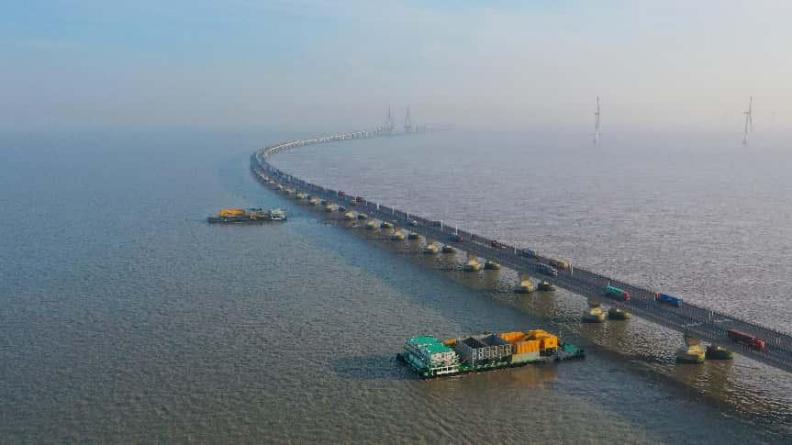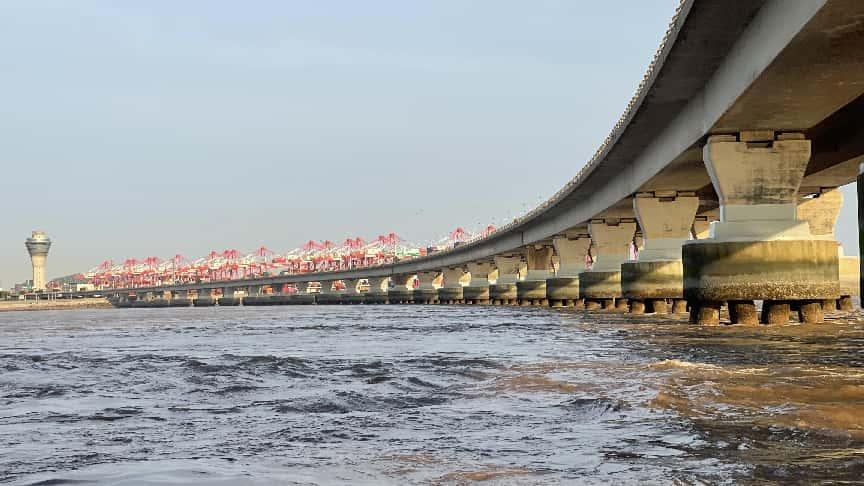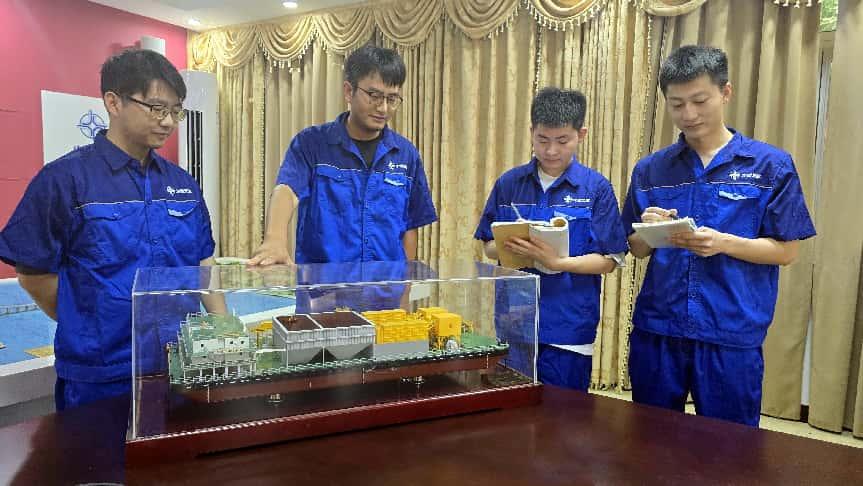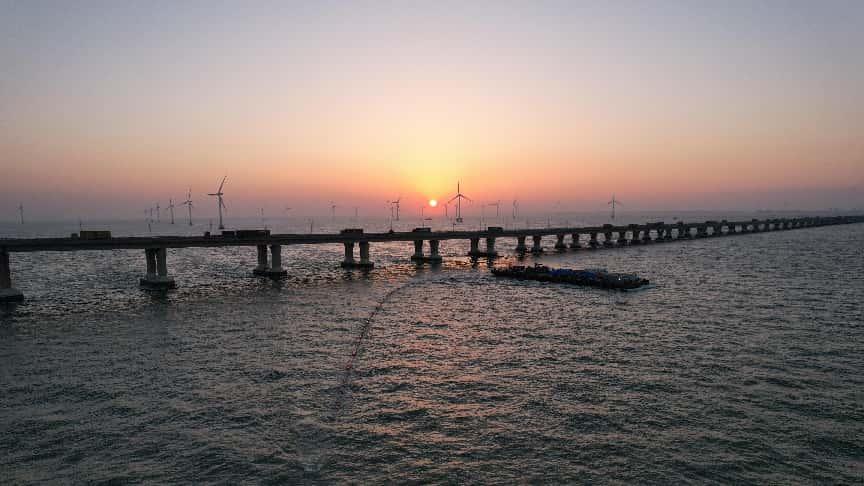
As the first pile foundation protection project for a cross-sea bridge in China, the project primarily focuses on systematically carrying out riprapping protection for 205 excessively eroded areas of bridge pier pile foundations within the scope of a bridge approximately 32.5 kilometers long. From "technical blankness" to "precise protection", the project team has overcome technical challenges such as complex seabed geological protection, high-precision underwater riprapping of complex batter piles with low clearance, and innovatively developed specialized equipment for scour protection of cross-sea bridges, providing a solid guarantee for the long-term operational safety of the Donghai Bridge.
Facing the challenge: the "escort battle" for bridge safety in marine environment
As China's first truly offshore cross-sea bridge, the Donghai Bridge serves as the sole land transportation hub connecting the Yangshan Deepwater Port Area and Shanghai. Due to various natural factors such as the decreasing sediment from the Yangtze River, tides, and topography, varying degrees of scouring have occurred in the seabed area around the piers of the Donghai Bridge, adversely affecting the stability of the bridge structure. In response to this issue, the project team has participated in protective tests and emergency works to verify the feasibility and effectiveness of the protective design. In April 2021, they officially undertook the construction of protective works for the excessively scoured areas around the piers of the Donghai Bridge.

In order to win this offshore "escort battle", the project team always pays attention to weather and wind and waves changes, coordinates offshore construction deployment, dispatches nearly a hundred ships of various types, organizes elite troops to stay at sea, and accurately controls the window period of tidal operations. They have completed the pre production of 170000 cubic meters of interlocking blocks, laid nearly 920000 square meters of soft rafts, dumped and filled nearly 180000 cubic meters of stone prism embankments, 745000 cubic meters of bagged crushed stones, and 810000 cubic meters of bagged concrete. The builders of Sanhang not only forge high-quality projects through sincere cooperation, but also safeguard their lives with a scientific safety management system, achieving a historic leap from "bridge construction" to "bridge protection", demonstrating the excellent engineering concept of "safety first, quality oriented".
Innovation Challenge: Building a Mobile Fortress for Offshore Construction
In the construction of pile foundation protection for Donghai Bridge, the project team overcame multiple technical challenges from theory to practice.
Research has been conducted on the erosion mechanism, protective design, and specialized construction equipment for the pier and pile foundation of Donghai Bridge. Innovative application demonstrations have been carried out on key technologies for erosion protection design, such as "bagged crushed stone, bagged concrete, and edge soft bottom protection", "active hook protection of erosion pit edges", and "new solidified soil protection"; In addition, we independently developed special construction equipment - special ship for oblique chute dumping and filling and construction ship integrating bagged concrete preparation and dumping and filling between pile groups. Compared with traditional water riprap, the loss of dumping and filling decreased by about 16%, and the work efficiency of offshore operations doubled, realizing the goal of cost reduction and efficiency increase.

In response to the challenges of on-site safety management, the project team innovatively developed an underwater chute stone throwing positioning monitoring system by integrating GPS signals, sensor data, depth sounder information, and submarine pipeline maps, achieving a "one screen display" of the entire operation process, which allows builders to intuitively view the effectiveness of stone throwing and protection. By relying on the "intelligent sentry" on board, not only can the precise positioning error of underwater filling be controlled within 10 centimeters, but it also effectively avoids the risk of collision between the operating vessel and the bridge pier, building a digital protection network for safety production.

New construction ships also take the living quarters and material support system as the core support, efficiently dispatch personnel and resources, break through the time constraints of traditional underwater operations, and promote the leap forward development of offshore engineering operations in the direction of "all-weather, intensive, and intelligent". As a result, the project team achieved excellent results by completing 205 bridge pier protections 25 days ahead of schedule.
Achievement Implementation: Building a Strong Security Line and Empowering Regional Development
The successful implementation of the protection project for the excessive erosion area of the bridge piers of Donghai Bridge provides a leading "theoretical+practical" dual basis for the systematic development of cross sea bridge pile foundation protection technology. It not only helps to improve the level of Shanghai International Shipping Center, but also empowers the high-quality development of the Yangtze River Delta economy with "hardcore technology". At the handover acceptance meeting, experts commented, "This is not only an engineering achievement, but also a replicable 'Chinese solution' for coastal bridge erosion prevention

The research results related to this project have obtained multiple invention patents, utility model patents, and first-class water transportation construction method certifications, and have won the Water Transportation Science and Technology Progress Award. Multiple Chinese core papers have been published. The project related topics have recently passed the performance evaluation meeting for the "Key Technology for Enhancing the Resilience of Coastal Transportation Hydraulic Structures" project under the "Transportation Infrastructure" key special project of the "14th Five Year Plan" national key research and development plan. After being certified by the expert group, this achievement has improved the level of scour protection technology for cross sea bridges under similar conditions, filled the relevant technical gaps, and provided a reference for design and construction technology guidelines for scour protection engineering of cross sea bridge piers.
In the future, the project team will actively promote successful experiences and strive to apply relevant technologies in more coastal bridges, offshore wind power, cross sea engineering construction, and deep-sea development projects, further driving the upgrading of related equipment manufacturing and industrial chains.
With the comprehensive construction of the "safety barrier" of the Donghai Bridge, this economic artery connecting land and sea will serve regional integration development more steadily, injecting new momentum into the synergy of industries and people's well-being in the Yangtze River Delta. (Fu Junjie, Third Navigation Bureau)
